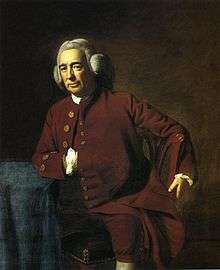Silvester Gardiner
Dr. Silvester Gardiner (June 29, 1708 – August 8, 1786) was a physician, pharmaceutical merchant and land developer of Maine.
Silvester Gardiner | |
|---|---|
 Silvester Gardiner, c. 1772, by John Singleton Copley | |
| Born | June 29, 1708 |
| Died | August 8, 1786 (aged 78) |
| Occupation | Physician, drug merchant and land developer |
| Known for | founding Gardiner, Maine |
| Spouse(s) | Ann Gibbons Abigail Eppes(nee Pickman) Catherine Goldthwaite |
Early years
He was born in South Kingstown, Rhode Island, the son of William Gardiner and Abigail Remington.[1] After studying medicine in New York, London and Paris, Dr. Gardiner opened a practice in Boston, where he became a lecturer on anatomy. He actively promoted inoculation for small pox, for which he proposed and established a hospital in 1761. But he made his fortune importing drugs for distribution and sale. He contributed generously to the construction of Boston's King's Chapel, where he was a warden, and also to the compilation and publication of a prayer book. But he is most remembered for his purchase and development of over 100,000 acres (400 km²) of wilderness on the Kennebec River in Maine, where he founded what is today the city of Gardiner.[2]
Early achievements
A proprietor of the old Plymouth Patent, his efforts to settle the territory were unceasing between 1753 and the American Revolution. He selected the location of Gardinerstown Plantation, established in 1754 at the head of navigation on the Kennebec River, at its confluence with the Cobbosseecontee Stream, which had falls to provide water power for industry. A millwright, carpenter and other workmen were induced to settle and build his town. He promoted immigration and land cultivation. He contributed a valuable library, and built the first Episcopal church in Pittston, from which Gardinerstown would be set off in 1760.[3]
Political leanings
But in 1774, Dr. Gardiner added his name to a letter addressed to Massachusetts Royal Governor Thomas Hutchinson, affirming his allegiance to the Loyalist cause. When the British army evacuated Boston in 1776, Dr. Gardiner fled to Halifax, Nova Scotia. With few of his possessions, he then lived in Poole, England throughout the Revolutionary War.[4] In 1778, his name appeared in the Massachusetts Banishment Act, and his vast landholdings were confiscated. Even his personal collection of rare books were sold at auction. Because of an error in the confiscation of the Maine property, however, his heirs would be able to secure its return.[5]
Death
In 1783, Dr. Gardiner spent time in St. John's, Newfoundland, and in 1784 wrote a report enumerating its resources, advocating 11 reasons for settlement. In 1785, he returned to Newport, Rhode Island, where he died the following year and was interred under Trinity Church. The Christ Episcopal Church, built in 1820 beside the Gardiner common, bears his cenotaph.[6]
Family
He married three times, first to Anne Gibbins (or Gibbons) in around 1730, with whom he had all of his children prior to her death in 1771. His second marriage was to Love Eppes sometime prior to his departure from Boston in 1776; she died on November 3, 1780 after they moved to England. His third wife was Catherine Goldthwaite, who was about 49 years younger than him; they married in February 1785. After Gardiner's death, Catherine married W. Powell of Boston.[7]
Gardiner's first son, John Gardiner (1731-1793), was Attorney General of Saint Christopher Island and father of John Sylvester John Gardiner.[8]
References
- Hatch, 341
- J. W. Hanson, History of Gardiner, Pittston and West Gardiner, Smith & Company, Hallowell, Maine 1852
- George J. Varney, Historical Sketch of Gardiner, Maine; Boston, Massachusetts 1889
- Webster 1913, p. 6
- Louis Clinton Hatch, editor, Maine: a History, Volume 4, The American Historical Society, 1919
- Robert J. Erskine, Judge Lauren M. Sanborn and Dr. Elmer D. Colcord, The Gardiner Story; published by The City of Gardiner, Maine 1949
- Webster 1913, p. 8
- Webster 1913, pp. 8-9
Further reading
- Webster, Henry Sewall (1913). Silvester Gardiner. Gardiner, Maine: The Reporter-Journal Press. Retrieved 13 April 2020.
External links
| Wikimedia Commons has media related to Silvester Gardiner. |
- Friends of Gardiner Heritage Museum
- Works by or about Silvester Gardiner in libraries (WorldCat catalog)